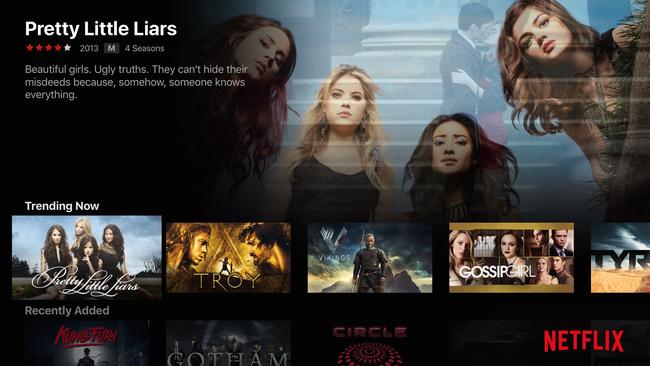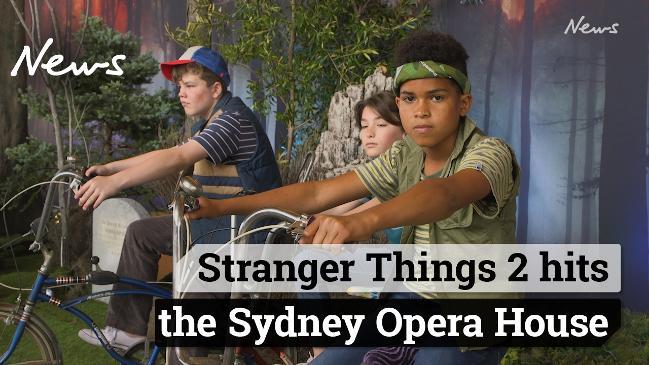Behind Netflix’s effort to get you addicted to its platform
IN THE increasingly competitive streaming wars technology is harnessed in interesting ways to keep you watching.

TV
Don't miss out on the headlines from TV. Followed categories will be added to My News.
IN THE competition for our eyeballs Netflix may well be winning — and Chris Jaffe’s job has a lot to do with it.
He has been at the company for more than seven years and has overseen its digital transformation to an internet-based service. As the VP of User Interface at Netflix, he is responsible for giving you the best possible experience when you log on to the streaming service.
To do so the company runs “hundreds” of tests a year, constantly tweaking and experimenting with the platform to keep us watching.
“It needs to constantly be getting easier and more frictionless,” Mr Jaffe told news.com.au.
“We see our users respond when we make it easier to find great things to watch, and that’s on the UI side,” he said. “But there’s also the personalisation side.”
That involves extensive testing of new features and refining its algorithms to create a product that is specifically catered to each user and their taste.
“We’re constantly trying to figure out what are the best things for you to watch now,” Mr Jaffe said. “That’s a very hard problem — as a company we’ve been trying to solve it for 20 years, even back in our early DVD days.”
The recommendations Netflix prompts you with are recalibrated every 24 hours with some rows of suggested content recalibrated every few hours. If a user takes more than 90 seconds to find something to watch, Netflix considers that the kiss of death in terms of keeping them on the platform.
When testing new features, the company usually chooses about a million randomly selected users to trial them on. Netflix won’t reveal what metrics its uses to determine if these tests are deemed a success but suffice to say increased time spent on the platform is the ultimate goal.
“We don’t reveal the metric because they’re always changing,” Mr Jaffe said.
“More than half the things we test don’t work. That might seem like a bad hit rate but when things don’t work, we learn a lot.”
One of those fails was a test years ago to let people connect Netflix to their Facebook account to easily share with their friends the shows and movies they were watching. “We all thought that would be a good idea and that people wanted to do that,” Mr Jaffe said. “But what we found is that people weren’t interested.”

COMPETING WITH SLEEP
The famous 1960s counterculture icon Timothy Leary coined the phrase: “Turn on, tune in, drop out”. He was referring to enjoying something a little stronger than TV but Netflix is currently pushing a rather similar slogan: “Stay home, sign in, binge on”.
The streaming giant has built an empire on the back of binge watching. According to the company’s own data, each individual subscriber spent 568 hours watching Netflix on average in 2015, TIME reported last year. That’s one hour, 33 minutes per day of streaming.
It’s little wonder Netflix CEO Reed Hastings once famously said his company was competing with sleep.
“Reed was having fun, we want you to sleep. We very much want people to take a break from binging,” a spokeswoman told news.com.au.
But Mr Jaffe seems somewhat less concerned about the sleep-deprived subscribers.
“This is something we talk about a lot internally,” he said. “In your spare time you have the choice to do anything you want, and we want to make Netflix as compelling as possible.”

NETFLIX AND VIRTUAL REALITY
The streaming giant said it would spend about $A1.3 billion on tech this year compared to about $A7.8 billion on producing original content.
Despite having a relatively small team on the tech side of things, part of that involves looking forward to the potential application of future technologies.
“All these technologies — whether it’s VR (virtual reality), AR (augmented reality) — we’re tracking all of them,” Mr Jaffe said.
When deciding whether to embrace an emerging technology, Netflix considers two things: does it have a direct application to movies and TV shows, and is there broad consumer adoption of the technology relative to storytelling?
“When we see those things coming together, that’s when it gets interesting for us,” Mr Jaffe said.
For the moment, Netflix has no plans to incorporate things like VR but the company is watching closely to see how the use of the technology unfolds in the gaming industry.
The reporter travelled to Singapore as a guest of Netflix.

Originally published as Behind Netflix’s effort to get you addicted to its platform


